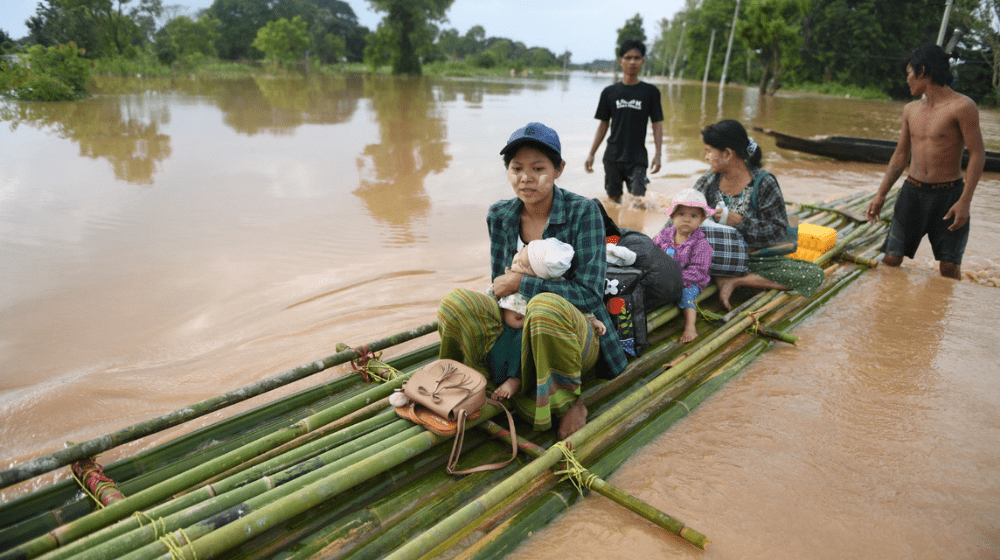Since 9 September, flooding and mudslides triggered by monsoon rains and the remnants of Typhoon Yagi have devastated 70 townships across 11 states and regions in Myanmar. More than 1 million people are estimated to have been affected—60% of which are women and girls—and more than 360 fatalities have so far been reported.
Women and girls are being disproportionately impacted by the flooding as it exacerbates existing vulnerabilities and inequalities, including heightening their risk of experiencing gender-based violence (GBV), economic exclusion, and health crises.
To better understand the gender-specific needs of the situation and ensure these needs are considered in every part of the flood response, the Myanmar Gender in Humanitarian Action Working Group is releasing situation reports on the impacts of the flooding on women and girls.
→Read Gender-Impact Flash Update No. 1.
The working group is co-chaired by UN Women and UNFPA and brings together civil society, community, and women’s rights organisations, NGOs, UN agencies, donors, and other stakeholders in Myanmar to ensure humanitarian responses address the gender specific needs of everyone affected.
The following summary captures the key gender-specific impacts and needs identified by working group members through their field staff, volunteers, networks and the communities they work in. For more in-depth analysis please read the full Gender-Impact Flash Update.
The rising risk of gender-based violence
One of the most urgent concerns is the increased risk of gender-based violence. Women and girls are particularly vulnerable to early marriage, unsafe migration, and trafficking as they flee to shelters or as families resort to dangerous coping mechanisms.
Without safe spaces, including gender-segregated latrines and bathing facilities, women and girls are vulnerable to exploitation and violence in overcrowded and poorly equipped temporary shelters. The lack of privacy threatens their physical safety and denies women and girls – including those who are pregnant, lactating or menstruating – their dignity in the face of an already traumatic situation.
The social and economic upheaval caused by the disaster has also led to increased tensions within households which organisations on the ground say is fuelling a spike in intimate partner violence.
Economic exclusion of women
With the destruction of farmlands and livestock, women working in small-scale farming and informal economies have lost their primary income sources. The floods have also amplified pre-existing gender inequalities. In the wake of the disaster, many women are taking on additional responsibilities for caring for children, the elderly, and other dependents, further limiting their ability to engage in income-generating activities or recovery efforts. This cycle of economic exclusion and increased care responsibilities leaves women even more vulnerable to poverty and exploitation.
Many households have lost livestock and farming equipment in the floods, causing long-term damage to their livelihoods. Photo: Courtesy of GiHA Working Group member in Shan State.
Lack of healthcare meeting women’s and girls’ needs
Many health facilities have been damaged or are unreachable due to fuel shortages and damage to roads. Where health care is accessible, it often does not include the specific services many women and girls need, including access to contraceptives, antenatal care, and safe childbirth services. Compounding these challenges, many women are unaware of where to access healthcare due to the destruction of communication networks.
Lack of safe food and water
As inflation rises and food prices soar, food insecurity has become another critical issue. Nutritious food, particularly that containing the nutrients pregnant and lactating women need, is scarce, and many families are struggling to meet their basic needs.
Contaminated water sources have led to outbreaks of diarrhoea and food poisoning, placing additional strain on already weakened health systems. For women and girls, the shortage of menstrual hygiene products and the absence of private sanitation facilities have further compromised their health and dignity.
Urgent action needed
As Myanmar faces one of its most devastating flooding crises, it is crucial that the response addresses the specific needs of women and girls. Local humanitarian organisations, including women-led and women’s rights organisations are on the front line of the response, but they are critically underfunded.
Without immediate and sustained interventions, the long-term impact on these vulnerable populations will be catastrophic. Almost 10 months into the year, the 2024 Humanitarian Needs and Response Plan is only 28% funded. To sustain the delivery of emergency assistance, additional resources are urgently needed.
To find out more about the gender-specific needs of women and girls affected by the current flooding, read the full Gender-Impact Flash Update: Myanmar Flooding, No.1.
For the latest updates and resources on the flooding visit the Monsoon Flooding 2024 resource page on the Myanmar Information Management Unit (MIMU) website.


